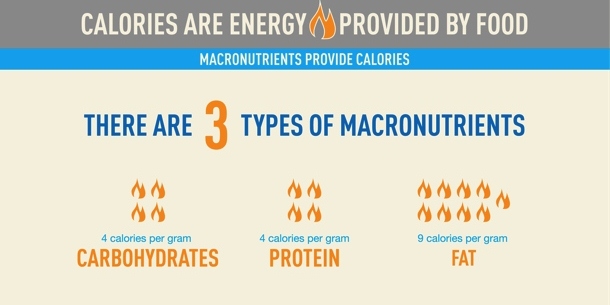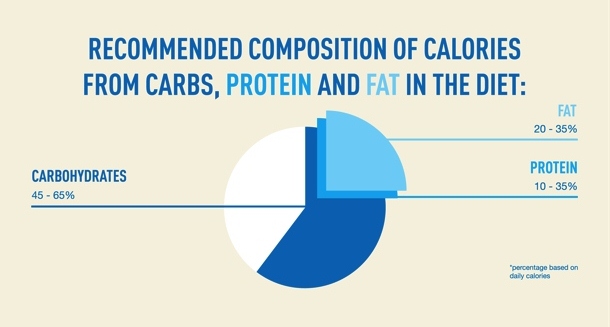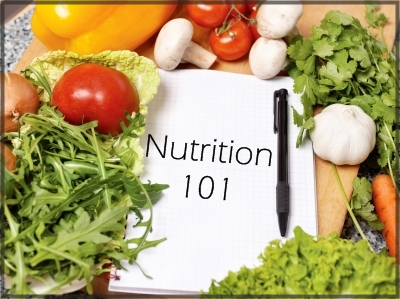 Today we’re talking calories and just how they add up to pounds, kilos or stones.
Today we’re talking calories and just how they add up to pounds, kilos or stones.
Calories need to band together and hire a public relations firm to make over their image. In the minds of many American women, the word ‘calorie’ connotes a bad, bad thing. But the truth is that calories are simply a unit of measure, used to describe the amount of potential energy contained in a given food.
A high-calorie food delivers more firepower than a low-calorie food, so it can get you through a day of chasing the kids or hiking the trails better than its low-cal cousins. Of course, if you’re not doing anything strenuous, extra calories can just make you fat. Knowing how many calories is just right is a challenge, but the more you know about this nifty measurement, the better.
 Calories come from macronutrients, which many of you may know as carbohydrates, proteins and fats (we will be covering these macronutrients in other lessons). Macronutrients differ from micronutrients in major two ways: they are required in large amounts by the body and provide energy. Micronutrients are required in much smaller amounts (hence the micro-) and have important structural and functional roles but don’t provide energy.
Calories come from macronutrients, which many of you may know as carbohydrates, proteins and fats (we will be covering these macronutrients in other lessons). Macronutrients differ from micronutrients in major two ways: they are required in large amounts by the body and provide energy. Micronutrients are required in much smaller amounts (hence the micro-) and have important structural and functional roles but don’t provide energy.
 A diet balanced in these three macronutrients is important for meeting the body’s broad needs. For example, carbohydrates largely fuel our brains and physical activity, proteins are used to build and maintain lean muscle, and dietary fats contain important building blocks for all cells in the body. While your body needs all three of these macronutrients, your body needs different percentages of these macronutrients to create the balance it needs to perform at optimum efficiency and maintain health.
A diet balanced in these three macronutrients is important for meeting the body’s broad needs. For example, carbohydrates largely fuel our brains and physical activity, proteins are used to build and maintain lean muscle, and dietary fats contain important building blocks for all cells in the body. While your body needs all three of these macronutrients, your body needs different percentages of these macronutrients to create the balance it needs to perform at optimum efficiency and maintain health.
You’re probably well aware that consuming too many calories leads to weight gain. Eat too many calories from any of the 3 macronutrients, and they’ll be converted to fat. Conversely, consume fewer calories than you expend and those fat stores will be used up to produce energy. Weight maintenance is the fine art of energy balance.
 It seems very calculated but equating calories to pounds of fat is really just a scientific approximation.
It seems very calculated but equating calories to pounds of fat is really just a scientific approximation.
Here’s a quick overview of the math:
- 1 pound of fat tissue weighs 454 grams – fact.
- Approximately 87% of fat tissue (or 395 grams) is actually fat. The composition of fat tissue may vary slightly from person-to-person, and study-to-study.
- 1 gram of fat provides about 9 calories of energy, though it could be anywhere in the range of 8.7 – 9.5 calories per gram according depending on which journal article you read.
- 395 grams of fat at 9 calories per gram adds up to 3,555 calories per pound of body fat, which is again rounded to 3,500 for ease of calorie counting. 1 pound is roughly equivalent to 0.45 kilograms or 0.07 stone.
Calories and Your Body’s Efficiency
Have you ever wondered why, for so many people (and especially for anyone older than 30 years old), weight gain seems to be a fact of life? It’s because the human body is way too efficient! It just does not take that much energy (or calories from food) to maintain the human body at rest; and when exercising, the human body is amazingly frugal when it comes to turning food into motion.
Even while we’re being completely lazy, our bodies are obviously still very busy (they’ve got a big show to run).
The number of calories burned at rest is called the basal metabolic rate, and it’s a measure of how much energy your body uses just to keep all of your complex bodily functions up and running and in check (i.e. your body temperature regulated, your heart beating, your brain humming, and so on).
The concept of burning off the body’s energy stores while doing absolutely nothing is kind of exciting, until you realize how little you would have to eat in order to avoid putting on extra weight. There are many factors that can determine how your body uses calories. Depending on your , height, weight, gender, physical conditioning and genetics, the average calorie usage is anywhere from 1600 to 2100 calories.
How many Calories do I Burn doing Nothing?
Here’s the formula to find your resting metabolic rate:
For Women: BMR = 655 + (4.35 x weight in pounds) + (4.7 x height in inches) – (4.7 x age in years)
For Men: BMR = 66 + (6.23 x weight in pounds) + (12.7 x height in inches) – (6.8 x age in years)
At rest (Rough estimate for 150 lb) for example, while sitting and watching television), the human body burns only about 12 calories per pound of body weight per day (26 calories per kilogram). That means that if you weigh 150 pounds (68 kg), your body uses only about:
150 X 12 = 1,800 calories per day
(Twelve calories per pound per day is a rough estimate )
Efficiency in Motion
In motion, the human body also uses energy very efficiently. For example, a person running a marathon (26 miles or 42 km) burns only about 2,600 calories. In other words, you burn only about 100 calories per mile (about 62 calories per km) when you are running.
You can see just how efficient the human body is if you compare your body to a car. A typical car in the United States gets between 15 and 30 miles per gallon of gasoline (6 to 12 km/L). A gallon of gas contains about 31,000 calories. That means that if a human being could drink gasoline instead of eating hamburgers to take in calories, a human being could run 26 miles on about one-twelfth of a gallon of gas (0.3 L). In other words, a human being gets more than 300 miles per gallon (120 km/L)! If you put a human being on a bicycle to increase the efficiency, a human being can get well over 1,000 miles per gallon (more than 500 km/L)!
 That level of efficiency is the main reason why it is so easy to gain weight. It’s very easy to do nothing (or close to it) without even realizing it, and we very rarely are conscious enough of our activity levels to adjust our diets to reflect the small number of calories we are burning.
That level of efficiency is the main reason why it is so easy to gain weight. It’s very easy to do nothing (or close to it) without even realizing it, and we very rarely are conscious enough of our activity levels to adjust our diets to reflect the small number of calories we are burning.
For example, consider the recommendation of taking a minimum of 10,000 steps a day. Averaging this many miles a day (roughly 5) would do a good job of increasing the amount of food you can eat, and keeping extra weight off – so long as you were not overindulging at the dinner table on a regular basis. Unfortunately, very few people actually cover that distance; most people average around 3,500 steps a day. Hitting around only 30% of your daily recommended steps gives you very little extra room to eat above the number of calories that are burned at rest (that resting basal metabolic number).
Yes, the body burns calories while you are otherwise doing nothing at all, but that energy is easily consumed in the food that you eat if you don’t add some intentional movement into your day. Lazy days are fantastic; just make sure that you don’t go too many days in a row without having left the couch.
By now we all know that weight maintenance or loss is a matter of energy burned versus energy consumed, and it’s clear that exercise can significantly increase the food that we can eat each day without putting on extra weight.
If you have been struggling with weight or find that diets just aren’t working for you, it’s likely that you need to take an honest look at your activity levels verses your calorie consumption.
Up next is carbohydrates, so be sure to check back for part two of the Nutrition 101 series!
You may also like:
- Six Weeks to a Healthier Diet
- Smart Start Menu Series
- Tips for putting together healthy menus
- Walk Talk Series
Just click on the link to take you to the topics in the series
- Nutrition 101 – Introduction to basic Nutrition
- Nutrition 101 – Calories
- Nutrition 101 – Carbohydrates
- Nutrition 101 – Proteins
- Nutrition 101 – Fats
- Nutrition 101 – Micronutrients ( Vitamins and Minerals)
- Nutrition 101 – Fiber
- Nutrition 101 – Water
- Nutrition 101- Recap – 5 Tips to Eat More Nutritiously
SOURCE: Elle Penner, M.P.H., R.D., Dietary Reference Intakes for Energy, Carbohydrate. Fiber, Fat, Fatty Acids, Cholesterol, Protein, and Amino Acids,


